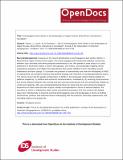| dc.contributor.author | Fraser, James | |
| dc.contributor.author | Leach, Melissa | |
| dc.contributor.author | Fairhead, James | |
| dc.coverage.spatial | Guinea | en_GB |
| dc.date.accessioned | 2014-09-23T09:37:07Z | |
| dc.date.available | 2014-09-23T09:37:07Z | |
| dc.date.issued | 2014-09 | |
| dc.identifier.citation | Fraser, J., Leach, M. & Fairhead, J. (2014) ‘Anthropogenic Dark Earths in the landscapes of Upper Guinea, West Africa: Intentional or Inevitable?’ Annals of the Association of American Geographers, 10/092014. DOI: 10.1080/00045608.2014.941735 | en_GB |
| dc.identifier.uri | https://opendocs.ids.ac.uk/opendocs/handle/20.500.12413/4472 | |
| dc.description.abstract | Drawing on the recent identification of anthropogenic dark earths (ADEs) in West Africa's Upper Guinea forest region, this article engages with Amazonian debates concerning whether such enriched soils were produced intentionally or not. We present a case study of a Loma settlement in Northwest Liberia in which ethnography, oral history, and landscape mapping reveal subsistence practices and habitus that lead African dark earths (AfDEs) to form inevitably around settlements and farm camps. To consider the question of intentionality and how the inevitability of AfDE is experienced, we combine historical and political ecology with elements of nonrepresentational theory. The former show how the spatial configuration of AfDEs in the landscape reflect shifting settlement patterns shaped by (1) political and economic transformations, mediated by (2) enduring ritual practices and social relations between first-coming and late-coming social groups that are symbolically related as uncles and nephews. We use nonrepresentational theory to show how the Loma phenomenological experience of these soils and their origins is better conceptualized in terms of sensual objects, the formation of which is inflected by these social and political processes. We thus reframe the debate away from intentionality, to theorize enriched anthropogenic soils and landscapes in terms of shifting sociocultural, political, and historical factors interplaying with the practical, sensually experienced, and inevitable effects of everyday life. | en_GB |
| dc.description.sponsorship | ESRC | en_GB |
| dc.language.iso | en | en_GB |
| dc.publisher | Taylor & Francis | en_GB |
| dc.rights | This is an Accepted Manuscript of an article published in Annals of the Association of American Geographers on 10/09/2014, available online: http://www.tandfonline.com/10.1080/00045608.2014.941735 | en_GB |
| dc.rights.uri | http://www.ids.ac.uk/files/dmfile/IDSOpenDocsStandardTermsOfUse.pdf | en_GB |
| dc.subject | Environment | en_GB |
| dc.title | Anthropogenic Dark Earths in the landscapes of Upper Guinea, West Africa: Intentional or Inevitable? | en_GB |
| dc.type | Article | en_GB |
| dc.rights.holder | Taylor & Francis | en_GB |
| dc.identifier.externaluri | http://www.tandfonline.com/10.1080/00045608.2014.941735 | en_GB |

